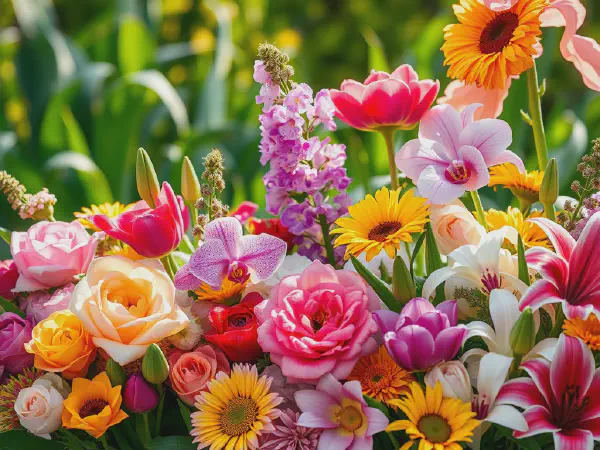Explore the Beautiful Types of Flowers: A Comprehensive Guide

Types of Flowers: A Comprehensive Guide
Flowers are a vital part of the plant kingdom, showcasing an array of colors, shapes, and fragrances that capture the imagination. Understanding the various types of flowers not only enhances our appreciation of nature but also aids in gardening, floral arrangement, and landscape design. There are many different categories and species of flowers that can be found across the globe, each with unique characteristics. This article will delve into the different types of flowers and their distinct features.
The classification of flowers can be broadly divided into several categories, including common garden varieties, wildflowers, indoor flowers, flower embellishments, and regional types of flowers. Each category contains diverse species that cater to different climates, uses, and preferences. From the familiar roses of a garden to the vibrant hues of wildflowers in meadows, the types of flowers available to us are truly astounding. This article will explore these categories thoroughly, providing insight into the beauty that flowers bring to our world.
One of the remarkable aspects of flowers is their symbolism and significance in various cultures. Across the globe, flowers are often used to convey emotions and messages. For instance, roses symbolize love, while daisies represent innocence. Understanding the meanings of different flower types can enrich our connections with others and enhance the power of gifting flowers on special occasions. Whether it is for personal enjoyment or as a thoughtful gesture, the world of flowers has much to offer in terms of variety and significance.
Gardening enthusiasts often seek to know more about the types of flowers that they can cultivate in their yards or gardens. Different flowers require specific care, including sunlight, water, and soil conditions, making it essential for gardeners to understand each flower's unique needs. This can significantly impact the success of growing flowers and ensure a thriving garden. As we explore the types of flowers in this article, we will also offer tips for cultivation and care to help you create a flourishing floral space.
In summary, flowers are an integral part of our environment that captivates our senses and enriches our lives. By learning about the types of flowers and their individual characteristics, we can deepen our appreciation for nature's beauty and make informed choices about flower selection for various purposes, whether for gardening, gifting, or decoration.
Common Types of Flowers
Roses are perhaps the most recognized flowers around the world, celebrated for their beauty and symbolic meanings. They come in various colors, each conveying different sentiments—red roses signify love, while yellow roses represent friendship. Additionally, there are numerous varieties of roses, including hybrid tea roses, floribunda roses, and climbing roses, each offering unique appeals for gardens and floral arrangements.
Tulips are another popular flower, known for their vibrant colors and elegant shapes. They thrive in spring and come in an array of hues, from soft pastels to bold reds and purples. Tulips are relatively easy to grow, making them a favorite choice for gardeners. To encourage healthy blooms, it is essential to plant them in well-drained soil and provide adequate sunlight.
Sunflowers, with their large, bright yellow heads, are known for following the sun as they grow. They can reach impressive heights and are relatively low-maintenance flowers, making them a perfect addition to gardens. Sunflowers attract pollinators, including bees and birds, and can be grown for their seeds, which are nutritious and enjoyable as snacks.
Lilies are a diverse group of flowers, featuring species such as the Asiatic lily, Oriental lily, and trumpet lily. Each type of lily has its unique fragrance and appearance. Lilies often symbolize purity and refined beauty, making them popular choices for bouquets and arrangements. Proper care, including regular watering and well-drained soil, ensures their stunning blooms.
Wildflowers
Identifying wildflower species can be both a rewarding and educational experience. Wildflowers can often be found in meadows, forests, and along roadsides, where they thrive in their natural habitats. Some common wildflower species include black-eyed Susans, bluebells, and poppies. Each species has unique features that make them easily recognizable, contributing to the rich tapestry of nature's blooms.
Understanding the habitat and growth conditions for wildflowers is essential for their conservation and successful cultivation. Many wildflowers prefer specific soil types, moisture levels, and sunlight exposure. When planting wildflowers, it's important to mimic their native environment to help them flourish and attract local pollinators.
Wildflowers play an essential role in supporting pollinators, further highlighting their importance in ecosystems. Planting native wildflower species can help attract bees, butterflies, and hummingbirds, which are crucial for pollination and maintaining healthy plant communities.
Wildflower blooms can vary significantly by season. Spring often brings an array of colorful flowers, while summer provides a lush display. Understanding the seasonal bloom times will allow gardeners and enthusiasts to plan accordingly and enjoy the beauty of wildflowers throughout the year.
Indoor Flowers
Popular indoor flower varieties include peace lilies, orchids, and African violets. Each of these flowers can thrive indoors when provided with the right conditions. Peace lilies are known for their elegant white blooms and air-purifying abilities, while orchids offer exotic beauty with unique shapes and colors. African violets are cherished for their charming blossoms and ability to bloom year-round under proper care.
Care requirements for indoor flowers often differ from those of outdoor varieties. Indoor flowers typically need moderate sunlight, regular watering, and occasional fertilization. It's important for indoor gardeners to be aware of their specific flower's needs and adjust care routines as needed to promote healthy growth.
Indoor flowers can be used as decorative elements in homes, adding color and life to living spaces. They can enhance the atmosphere in various rooms, such as brightening up a living room or creating a serene ambiance in a bedroom. Arranging indoor flowers in stylish pots or vases can elevate any interior design.
For those with low-light conditions, there are indoor flowers specifically suited for such environments. Plants like snake plants and pothos can thrive in reduced light while still providing greenery and beauty. Choosing low-light tolerant plants ensures that indoor gardening remains possible even in challenging conditions.
Flower Embellishments
Edible flowers have gained popularity not only for their beauty but also for their culinary uses. Flowers such as nasturtiums, pansies, and violets can brighten up salads and desserts while adding unique flavors. Understanding the uses and benefits of incorporating edible flowers into meals can enhance dining experiences.
Dried flowers have become a staple in crafting and decoration. Flowers like lavender, roses, and eucalyptus can be preserved and used in potpourri, wreaths, and other DIY projects. Using dried flowers in home decor adds a rustic charm and a touch of nature to interior spaces.
Flowers play a crucial role in floral arrangements, providing color, texture, and shape. Understanding the principles of floral arrangement, such as balance and harmony, can help in creating stunning displays. Whether for special occasions or everyday enjoyment, learning how to arrange flowers effectively can elevate any space.
Seasonal flower trends often see a rise in specific types of flowers based on the time of year. Spring brings a surge of tulips and daffodils, while summer showcases sunflowers and hibiscus. Being aware of these trends and incorporating seasonal flowers can enhance decorative themes and festivities throughout the year.
Regional Types of Flowers
Native flowers of North America include species like the purple coneflower and black-eyed Susan. Each of these flowers is well-suited to the climate and soil conditions of their respective regions, showcasing the beauty of indigenous flora. Conserving and planting native flowers helps preserve local ecosystems.
Tropical flowering plants, such as hibiscus and bougainvillea, are renowned for their stunning colors and exotic appeal. These flowers thrive in warm, humid conditions, making them popular choices for gardens and landscapes in tropical climates. With appropriate care, tropical flowers can add a touch of paradise to any setting.
European flower varieties include well-loved species like the lavender and the pansy. These flowers not only bring beauty to gardens but also serve various purposes, such as culinary, aromatic, and decorative uses. Recognizing the contributions of regional varieties can deepen appreciation for local flora.
Desert flowers, like the saguaro flower and desert marigold, exhibit remarkable adaptations to survive in arid environments. These flowers often have specialized mechanisms for water retention and can bloom beautifully despite harsh conditions. Studying desert flowers can inspire resilience in gardening practices and conservation efforts.
